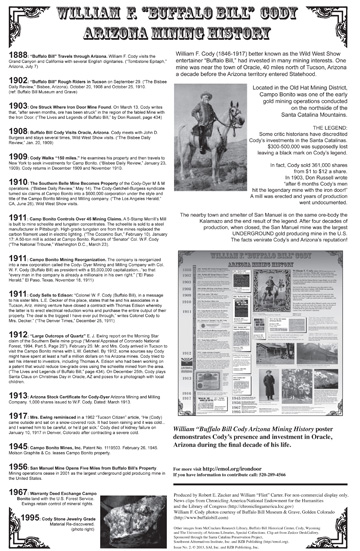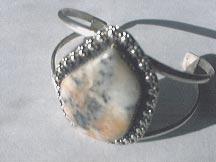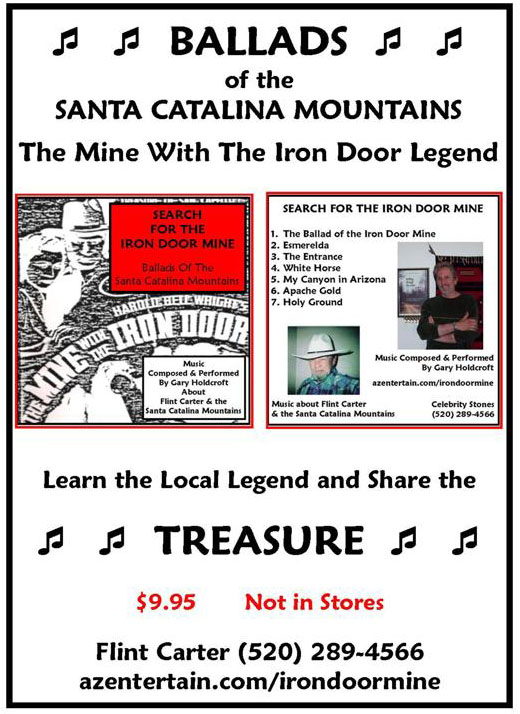|
Entertainment Magazine: Iron Door Mine: Flint Carter: Buffalo Bill Cody
Buffalo Bill Cody's Arizona Mining Ventures
William F. Cody (1846-1917) better known as the Wild West Show entertainer “Buffalo Bill,”
had invested in many mining interests. One mine was near the town of
Oracle, 40 miles north of Tucson, Arizona a decade before the Arizona
territory entered Statehood.
 Located
in the Old Hat Mining District, Campo Bonito was one of the early gold
mining operations conducted on the northside of the Santa Catalina
Mountains. Located
in the Old Hat Mining District, Campo Bonito was one of the early gold
mining operations conducted on the northside of the Santa Catalina
Mountains.
THE LEGEND:
Some critic historians have discredited
Cody’s investments in the Santa Catalinas. $300-500,000 was supposedly
lost mleaving a black mark on Cody’s legend.
In fact, Cody sold 361,000 shares from $1 to $12 a share.
In 1903, Don Russell wrote “after 6 months
Cody’s men hit the legendary mine with the iron door!”mA mill was
erected and years of production mwent undocumented.
The nearby town and smelter of San Manuel is on nthe same
ore-body the Kalamazo and the end result of the legend. After four
decades ofmproduction, when closed, the San Manuel mine was the largest
UNDERGROUND gold producing mine in the U.S.
The facts venirate Cody’s and Arizona’s reputation!
William “Buffalo Bill Cody Arizona Mining History poster
demonstrates Cody’s presence and investment in Oracle,
Arizona during the final decade of his life.
Courtesy of BZB Publishing, Inc. Flint Carter and Santa Catalina Historic Preservation Project.
Buffalo Bill Cody's Historic Timeline in Arizona
1888: “Buffalo Bill” Travels through
Arizona. William F. Cody visits the Grand Canyon and California with
several English dignitaries. (“Tombstone Epitaph,” Arizona, July 7,
1888)
1902: “Buffalo Bill” Rough Riders in Tucson on September
29. (“The Bisbee Daily Review,” Bisbee, Arizona). October 20, 1908 and
October 25, 1910. (ref: Buffalo Bill Museum and Grave)
1903: Ore Struck Where Iron Door Mine Found. On March 13,
Cody writes that, “after seven months, ore has been struck” in the
region of the fabled Mine with the Iron Door. (“The Lives and Legends of
Buffalo Bill,” by Don Russell, page 434)
1908: Buffalo Bill Cody Visits Oracle, Arizona. Cody
meets with John D. Burgess and stays several times, Wild West Show
visits. (“The Bisbee Daily Review,” Jan. 20, 1909)
1909: Cody Walks “150 miles.” He examines his property
and then travels to New York to seek investments for Camp Bonito.
(“Bisbee Daily Review,” January 23, 1909). Cody returns in December 1909
and November 1910.
1910: The Southern Belle Mine Becomes Property of the
Cody-Dyer M & M operations. (“Bisbee Daily Review,” May 14). The
Cody-Getchell-Burgess syndicate turned six claims at Campo Bonito into a
$600,000 corporation under the style and title of the Campo Bonlto
Mining and Milling company. (“The Los Angeles Herald,” CA, June 26).
Wild West Show visits.
1911: Camp Bonito Controls Over 45 Mining Claims. A
5-Stamp Merrill’s Mill is built to mine scheelite and tungsten
concentrates. The scheelite is sold to a steel manufacturer in
Pittsburgh. High-grade tungsten ore from the mines replaced the carbon
filament used in electric lighting. (“The Coconino Sun,” February 10).
January 17: A 50-ton mill is added at Campo Bonito. Rumors of “Senator”
Col. W.F. Cody (“The National Tribune,” Washington D.C., March 23).
1911: Campo Bonito Mining Reorganization. The company is
reorganized into a new corporation called the Cody- Dyer Mining and
Milling Company with Col. W. F. Cody (Buffalo Bill) as president with a
$5,000,000 capitalization...”so that “every man in the company is
already a millionaire in his own right.” (”El Paso Herald,” El Paso,
Texas, November 18, 1911)
1911: Cody Sells to Edison: “Colonel W. F. Cody (Buffalo
Bill), in a message to his sister Mrs. L.E. Decker of this place, states
that he and his associates in a Tucson, Ariz. mining venture have
closed a contract with Thomas Edison whereby the latter is to erect
electrical reduction works and purchase the entire output of their
property. The deal is the biggest I have ever put through,” writes
Colonel Cody to Mrs. Decker.” (“The Denver Times,” December 25, 1911)
1912: “Large Outcrops of Quartz” E. J. Ewing report on
the Morning Star claim of the Southern Belle mine group (“Mineral
Appraisal of Coronado National Forest, 1994, Part 5, Page 25”). February
25: Mr. and Mrs. Cody arrived in Tucson to visit the Campo Bonito mines
with L.W. Getchell. By 1912, some sources say Cody might have spent at
least a half a million dollars on his Arizona mines. Cody tried to sell
his interest to investors, including Thomas A. Edison who had been
working on a patent that would reduce low-grade ores using the scheelite
mined from the area. (“The Lives and Legends of Buffalo Bill,” page
434). On December 25th, Cody plays Santa Claus on Christmas Day in
Oracle, AZ and poses for a photograph with local children.
1913: Arizona Stock Certificate for Cody-Dyer Arizona
Mining and Milling Company. 1,000 shares issued to W.F. Cody. Dated:
March 1913.
1917: Mrs. Ewing reminisced in a 1962 “Tucson Citizen”
article, “He (Cody) came outside and sat on a snow-covered rock. It had
been raining and it was cold...and I warned him to be careful, or he’d
get sick.” Cody died of kidney failure on January 10, 1917 in Denver,
Colorado after contracting a severe cold.
1945: Campo Bonito Mines, Inc. Patent No. 1119503. February 26, 1945. Molson Graphite & Co. leases Campo Bonito property.
1956: San Manuel Mine Opens Five Miles from Buffalo
Bill’s Property. Mining operations cease in 2001 as the largest
underground gold producing mine in the United States.
1967: Warranty Deed Exchange Campo Bonito land with the U.S. Forest Service. Ewings retain control of mineral rights.
1995: Cody Stone Jewelry Grade Material re-discovered by Flint Carter.
Produced by Robert E. Zucker and William
“Flint” Carter. For non-commercial display only. News clips from
Chronicling America/National Endowment for the Humanities and the
Library of Congress (http://chroniclingamerica.loc.gov). William F. Cody photos courtesy of Buffalo Bill Museum & Grave, Golden Colorado (http://www.buffalobill.com)
Other images from McCracken Research Library, Buffalo Bill
Historical Center, Cody, Wyoming and The University of Arizona
Libraries, Special Collections. Clip art from Zedcor DeskGallery.
Sponsored through the Santa Catalina Preservation Project, Southwest
Altternatives Institute, Inc. and BZB Publishing (http://emol.org). Issue No. 2. © 2013, SAI, Inc. and BZB Publishing, Inc. Co.
© 2013 EMOL.org. Entertainment Magazine. All rights reserved.
|
 Cody
Stone is mined from the Catalina Mountains in Southern Arizona, USA-
the same mountains mined by Buffalo Bill Cody. Designed as jewelry grade
gold and silver in quartz, Codystone specimens and hand made items are
on display at the Oracle Inn Steakhouse & Saloon in Oracle, Arizona.
Call Flint at 520-289-4566 or email finder@emol.org. Cody
Stone is mined from the Catalina Mountains in Southern Arizona, USA-
the same mountains mined by Buffalo Bill Cody. Designed as jewelry grade
gold and silver in quartz, Codystone specimens and hand made items are
on display at the Oracle Inn Steakhouse & Saloon in Oracle, Arizona.
Call Flint at 520-289-4566 or email finder@emol.org.
|
"Ballads of the Santa Catalina Mountains" CD
Listen to songs and ballads on CD about
the Iron Door Mine, the Santa Catalina Mountains, the Old West and
about Arizona historian Flint Carter. $9.95. Call 520-289-4566 for more
information and to purchase copies.
|
|
 Located
in the Old Hat Mining District, Campo Bonito was one of the early gold
mining operations conducted on the northside of the Santa Catalina
Mountains.
Located
in the Old Hat Mining District, Campo Bonito was one of the early gold
mining operations conducted on the northside of the Santa Catalina
Mountains.
